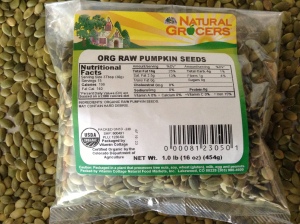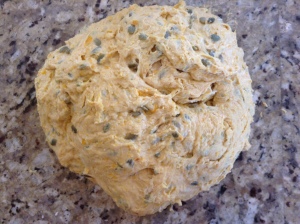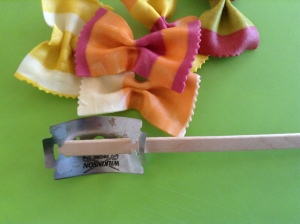I am always sleuthing through the local Asian markets and Mexican mercados. They always have better quality and greater variety of produce. I never know when I turn the corner to the next aisle what I will find. I had been eyeing the bakery items with pepitas or hulled pumpkin seeds but was deterred by the labor involved in husking the seeds. What luck, I was at my local health food store Vitamin Cottage Natural Grocers and found a bag of really fresh looking pepitas. This called for a new bake. The winter squash are plentiful now and so good, savory and sweet depending on the variety. This bread turned out really well and is dramatic with the orange hue and embedded pepitas.
Pepitas, winter squash and whey bread recipe.
I find it is best to weigh all ingredients if possible and metric makes scaling so easy.
Makes 2 one kg loaves or 4 half kg loaves.
Pre prep.
Roast and cool a winter squash with firm flesh that does not turn mealy when cooked, such as butternut or sugar pumpkin. I used a Tajikistan squash from my garden. The easiest method is to cut the squash in half and cook both halves cut side down on a tall-rimmed sheet pan. Depending on the variety it may release a lot of liquid. Cool, scoop out flesh and let it drip in a strainer until most of the moisture is removed. Run pulp through ricer or mash.
The pepitas have a better flavor when they have been roasted. I put mine on a separate pan and toasted them in the same oven with the squash, checking periodically for doneness.
Whey is the by-product from straining Greek yogurt or home made cheese. I make cheese regularly so always have some frozen whey for future use. You can substitute water but you will miss out on the browning of the crust from the Maillard reaction of the milk whey sugars.
Dough
1 kg bread flour
450 g cooked drained winter squash
450 ml (grams) whey, room temp. I used left over whey from my last batch of Quark cheese.
20 g salt
7g, (one packet) yeast
200 g pepitas, hulled pumpkin seeds
50 mls olive oil
Mixing
Place the squash in a large bowl, add the whey and mix a few times, add pepitas and olive oil, stir, add yeast and stir until incorporated. Sprinkle salt over dough and incorporate. Now stir in bread flour until just combined. Adding 100-200 mls (1/2 cup) at a time works best. Mix until just combined. This will be very sticky dough. Scrape dough out onto an oiled surface and let sit for about 15 minutes then give it a last very brief knead or stretch and fold to incorporate all the ingredients.
First Ferment 1.5 to 2.5 hours
Return dough to bowl, cover, wait until it doubles in size.
Shaping
Divide into 2 or 4 portions, a bench scraper works well for this. This dough is very sticky so I let it rise for another hour on parchment paper covered with a damp tea towel. It is so sticky it will stick to most bread forms.
Waiting
During this time preheat oven to 450°F/232°C. My oven is lined with unglazed quarry tiles and I use inverted terracotta pots as cloches. To prevent thermal shock the cloches or pots will need to be in the oven at the start of the preheat. The tiles will need 30 minutes time to heat up after the oven reaches final temperature so keep that in mind when timing your preheat. A cast iron Dutch oven will work as well but note that the knob on the lid will melt at most baking temperatures. Le Creuset sells stainless steel knobs in 3 sizes to replace the original phenolic one.
Note: I used stainless steel nuts, screws and washers as zinc and galvanized fittings will give off toxic fumes at high heat.
Bake 500 g loaves with lid of Dutch oven on or covered with cloche for 30 minutes then 5 minutes uncovered for 5 minutes.
Bake 1000 g loaves for 40 minutes covered then 5 minutes uncovered or until your desired crust color.
My final temperature was 201°F/94°C. I bake at a mile high so with a boiling point of 202°F/94.6°C I have never had a final temp above 201°F without burning the loaf.
Remove from oven and pot if using and cool on rack.
These loaves are tasty and quite dramatic with their orange hue and embedded pepitas.
Notes
If using a Dutch oven some planning is helpful. After ½ hour at 450°F I will remove the pot and cover and set it on the stove. I then drop the scored loaf on parchment paper into the pot, quickly place the lid on and give it a quick shake to center the loaf and return it to the oven.
When I use the home made cloche I will remove the heated cloche from the oven and set it on the stove. I slide the scored loaf onto the oven tiles and replace the cloche. Both methods trap steam and significantly improve oven spring.
Scoring
I use a home made lame. It is just a craft stick threaded into a razor blade.















